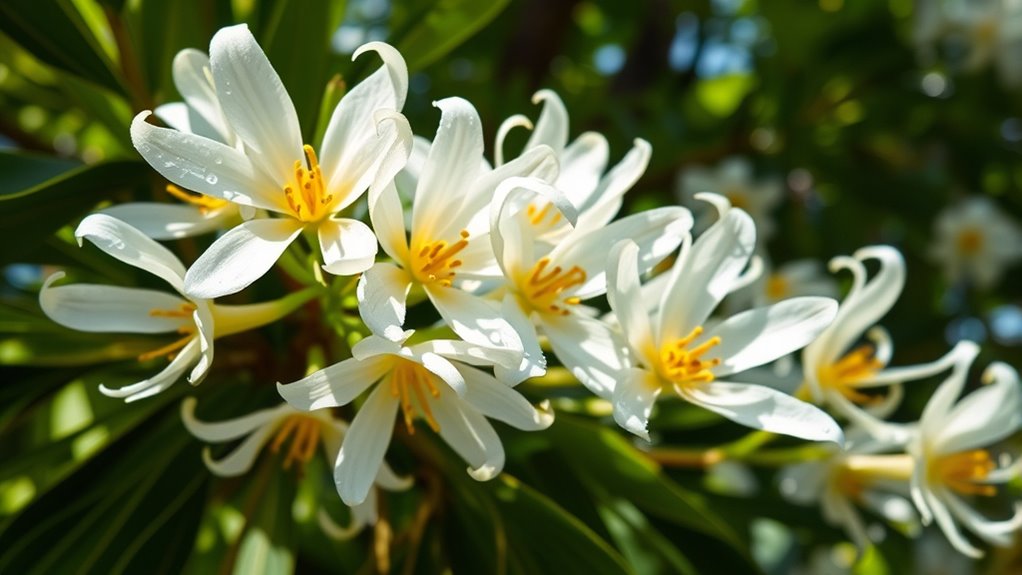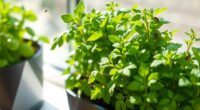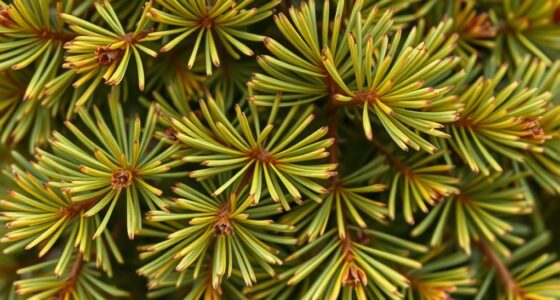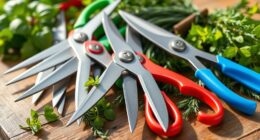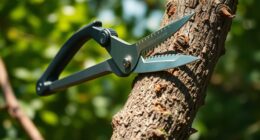If your soursop tree blooms but doesn’t set fruit, verify pollination is effective by encouraging bee activity with nearby nectar-rich flowers and avoiding pesticides during bloom times. You can also try hand pollination using a soft brush when flowers open. Supporting healthy growth with proper watering, nutrients, and pest control helps fruits develop. For more detailed tips on improving your tree’s fruiting success, discover strategies to boost pollination and care that will turn blossoms into harvests.
Key Takeaways
- Ensure flowering coincides with bee activity; plant nectar-rich flowers nearby to attract pollinators.
- Avoid pesticides during flowering to protect bees and improve pollination success.
- Perform hand pollination using a soft brush when natural pollinators are scarce or flowers are not setting fruit.
- Improve soil health with organic matter and ensure proper watering to support fruit development.
- Regularly monitor and control pests that may damage flowers or developing fruit, enhancing fruit set.
Understanding the Pollination Process of Soursop Trees
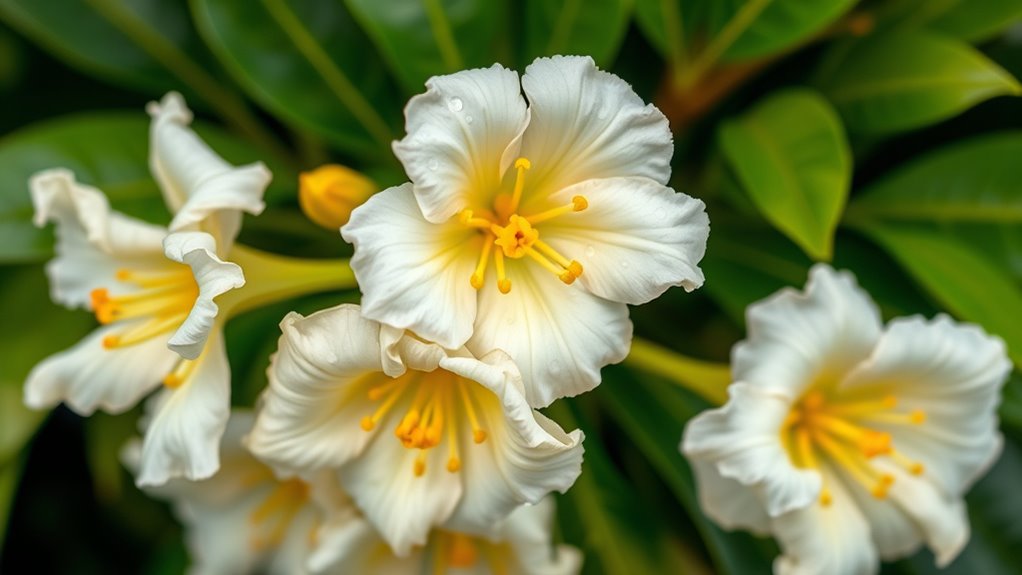
Understanding how soursop trees are pollinated is essential if you’re experiencing flowers but no fruit. The key lies in pollination timing, which must align with bee activity for successful fruit set. Bees are the primary pollinators, and their activity peaks during specific times of the day, usually mid-morning to early afternoon. If your flowers open when bees are inactive, pollination chances decrease. You can encourage bee activity by planting nearby flowering plants or avoiding pesticides during peak bee hours. Additionally, observing when your soursop flowers bloom helps you understand when pollination is most likely to occur. Ensuring that pollination coincides with bee activity increases the likelihood of fruit development, so paying attention to these timing factors is fundamental for a healthy soursop harvest. Regularly monitoring flower bloom times can also help maximize pollination success and improve fruit yield. Creating a pollination-friendly environment by providing habitat and food sources for pollinators can further boost fruit production. Furthermore, understanding the pollination process helps in identifying potential issues and implementing effective solutions to promote fruit set.
Common Causes of Poor Fruit Development
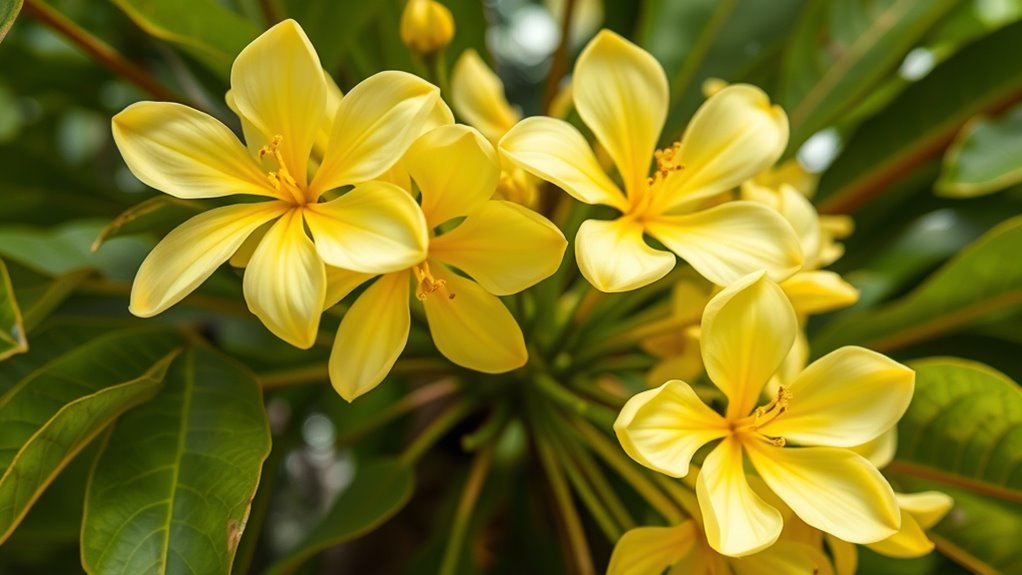
Even if your soursop tree blooms beautifully and pollination happens, several factors can still prevent fruit from developing properly. Poor soil nutrition is a common issue; if your soil lacks essential nutrients like nitrogen, phosphorus, or potassium, the tree may struggle to support healthy fruit growth. Regular pest control is also crucial—pests such as fruit flies or beetles can damage developing fruit or hinder pollination success, leading to poor fruit set. Additionally, overwatering or underwatering can stress the tree, affecting fruit development. Environmental stresses like extreme temperatures and inadequate sunlight further weaken the tree’s ability to produce quality fruit. Proper watering techniques and maintaining optimal environmental conditions can significantly improve fruit development. Addressing these issues by improving soil nutrition and implementing effective pest control can markedly increase your chances of successful fruit development. Ensuring adequate pollination services, such as attracting pollinators or manually pollinating, can also enhance fruit set and quality.
Enhancing Pollination Through Natural and Hand Pollination Methods

To improve fruit set on your soursop tree, enhancing pollination is essential. Boosting bee activity nearby can naturally increase pollination rates, as bees are primary pollinators for soursop flowers. To attract more bees, plant nectar-rich flowers around your tree or avoid pesticide use during flowering. If natural pollination isn’t sufficient, consider hand pollination. Use a soft brush or cotton swab to gently transfer pollen from the male flowers to the female flowers’ stigma. Timing is vital—perform hand pollination when flowers are open and receptive. Combining these methods improves the chances of pollination, leading to better fruit development. By encouraging bee activity and supplementing with hand pollination, you increase your soursop tree’s chances of bearing fruit. Additionally, understanding the pollination process can help optimize your efforts and improve fruit production. A deeper understanding of home orchard management techniques can also contribute to healthier, more productive trees. Incorporating proper fertilization practices can further enhance flowering and fruiting success.
Optimal Care Practices for Fruitful Soursop Trees
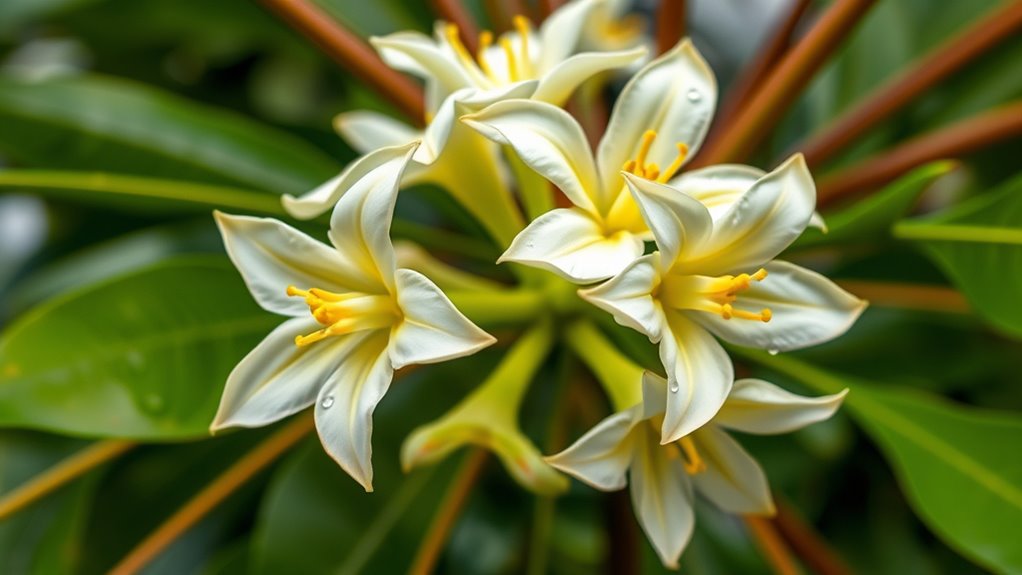
For your soursop tree to produce abundant fruit, providing ideal care is vital. Start by enriching the soil with appropriate amendments like compost or organic matter to improve drainage and nutrient levels. Healthy soil promotes strong growth and better fruit development. Regular pest control is also essential; inspect your tree for common pests such as scales, mites, or fruit flies, and address infestations promptly with organic or chemical treatments. Keep the area around the tree clean and remove fallen leaves or fruit to prevent pest buildup. Proper watering—deeply and consistently—ensures the roots stay healthy, while mulching helps retain moisture and regulate soil temperature. Additionally, understanding the pollination process is crucial, as it directly impacts flowering and fruiting success. Following these practices creates a thriving environment that encourages flowering and fruiting.
Troubleshooting and When to Seek Additional Help
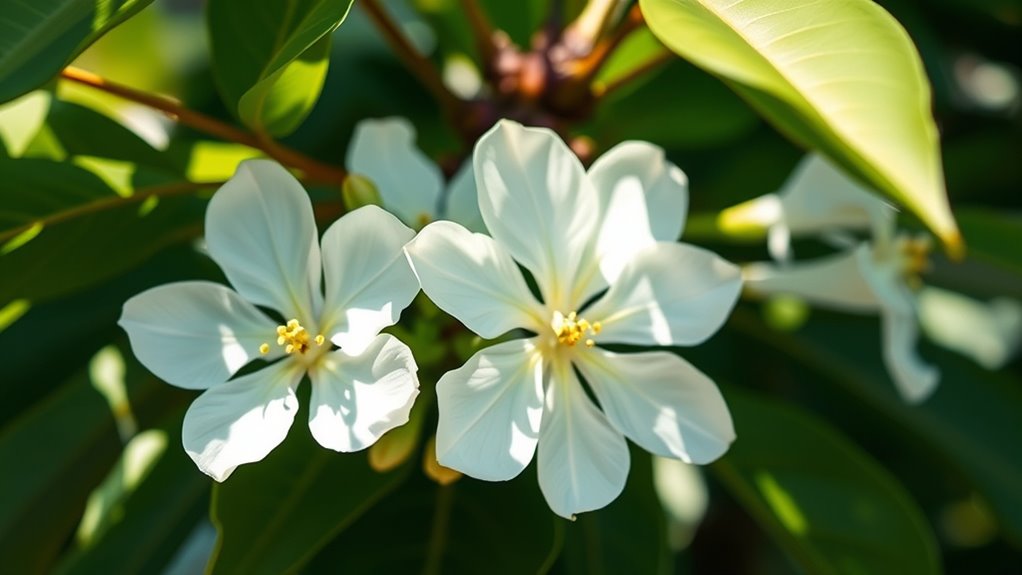
When your soursop tree flowers but doesn’t set fruit, it’s a sign that something might be out of balance. First, check your pest management practices; pests can damage flowers or hinder pollination. Look for common pests like scale insects or beetles and treat infestations promptly. Next, evaluate soil nutrition—deficiencies in nitrogen, potassium, or phosphorus can prevent fruit development. Conduct a soil test and amend as needed to ensure your tree receives essential nutrients. If these steps don’t resolve the issue, consider consulting a local arborist or horticulturist for advice. Sometimes, environmental stress or improper watering also play a role. Regularly monitor your tree and seek professional help when problems persist, ensuring healthier growth and better fruiting in future seasons. Additionally, understanding the pollination process can help you identify potential issues with fruit set. Proper beneficiary designation in your planting area can also promote better growth outcomes by ensuring the right conditions for pollinators and healthy development. Furthermore, providing adequate flowering conditions such as proper pruning and sunlight can encourage fruit production.
Frequently Asked Questions
Can Ph Levels of Soil Affect Soursop Flowering Without Fruit?
Yes, soil pH levels can affect your soursop tree’s flowering and fruiting. If the soil is too acidic or alkaline, it disrupts nutrient uptake, leading to poor flowering or no fruit. Maintaining a balanced nutrient profile and adjusting soil acidity as needed helps promote healthy blooms and fruit development. Regular testing and amendments ensure your tree gets the right conditions for ideal growth and fruit production.
Does Pruning Influence Fruit Production in Soursop Trees?
Pruning considerably influences fruit production in soursop trees. By practicing canopy management, you guarantee better light penetration and airflow, which boost flowering and fruiting. Flower thinning helps the tree focus its energy on developing fewer, healthier fruits rather than many small ones. Regular pruning encourages strong growth, improves fruit quality, and increases yield, making it an essential part of caring for a productive soursop tree.
Are There Specific Fertilizers That Promote Fruit Set in Soursop?
You might think any fertilizer works, but for soursop, specific fertilizer recommendations are essential. Using the right nutrients can turn your tree into a fruit-bearing powerhouse! Focus on fertilizers rich in potassium and phosphorus, which promote flowering and fruit set. Address nutrient deficiencies promptly, because ignoring them could mean a flowering tree that stubbornly refuses to bear fruit. Proper fertilization truly makes the difference between a flowering soursop and a fruitful harvest.
How Does Climate Change Impact Soursop Flowering and Fruiting?
Climate change impacts your soursop tree by causing temperature fluctuations that can disrupt flowering and fruiting cycles. You need to build climate resilience by providing shade and proper watering to protect against extreme weather. Warmer temperatures may promote flowering, but unpredictable shifts can hinder fruit development. Staying proactive and adjusting your care routines helps your soursop adapt, ensuring healthier blooms and better fruit yields despite climate challenges.
Are There Pest or Disease Issues That Prevent Fruit Development?
Imagine pests and diseases as silent thieves sneaking into your orchard, stealing the promise of fruit. If you neglect pest management and disease prevention, your soursop tree’s fruit development can be thwarted, like a garden choked by weeds. Regularly inspect for pests, apply natural deterrents, and keep diseases at bay. By actively managing these threats, you support healthy growth, ensuring your tree bears the delicious fruit you envision.
Conclusion
By understanding the pollination process and addressing common issues, you can turn your soursop tree from a shy bloomer into a fruitful bounty. Think of your tree as a delicate dance partner—when you provide the right care and assistance, it’s more likely to step confidently into the rhythm of fruit production. With patience and proper attention, you’ll nurture a thriving soursop that rewards your efforts with luscious, juicy fruits.
